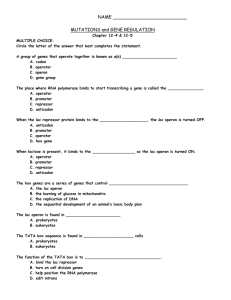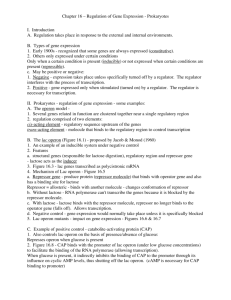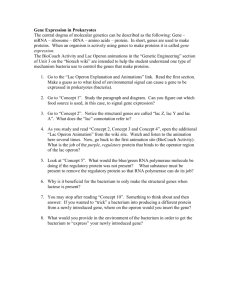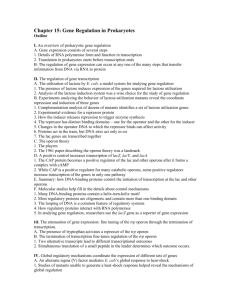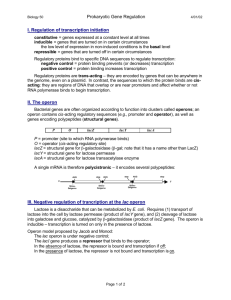Operon
advertisement
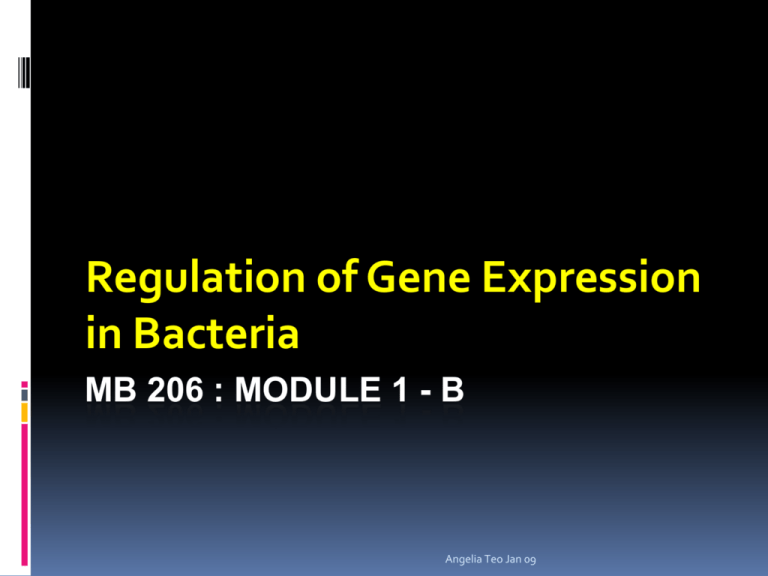
Regulation of Gene Expression in Bacteria MB 206 : MODULE 1 - B Angelia Teo Jan 09 Regulation of Gene Expression A cell contains the entire genome of an organism– ALL the DNA. Gene expression = transcribing and translating the gene Regulation allows an organism to selectively transcribe (and then translate) only the genes it needs to. Genes expressed depend on the type of cell the particular needs of the cell at that time. Principles of Gene Regulation Angelia Teo Jan 09 How Are Genes Regulated? Genes located in coherent packages called operons operons has 4 parts regulatory gene - controls timing or rate of transcription promoter - starting point operator - controls access to the promoter by RNA polymerase structural genes NOTE = operons regulated as units Angelia Teo Jan 09 Gene Regulation in Prokaryotes Prokaryotes organize their genome into operons Operon = a group of related genes One promoter sequence at the very beginning All of the genes will be transcribed together (in one long strand of RNA. Principle of Gene Regulation RNA polymerase binds to DNA at promoters. Transcription initiation is regulated by proteins that bind to or near promoters. Repression of a repressible gene: (i.e., negative regulation) repressors (vs activitors) bind to operators of DNA. Repressor is regulated by an effector, usually a small molecules or a protein, that binds and causes a conformational change. Activitor binds to DNA sites called enhancer to enhance the RNA polymerase activity. (i.e., [positive regulation) Induction of an inducible gene, e.g., heat-shock genes. Angelia Teo Jan 09 General organization of an inducible gene Regulation of Genes Transcription Factor (Protein) RNA polymerase DNA Regulatory Element Gene Regulation of Genes New protein RNA polymerase Transcription Factor DNA Regulatory Element Gene Gene Expression How much protein is in a cell (and active)?? Some gene products are necessary only some of the time Response to environmental changes (eg. Temperature) Response to life events (eg. Reproduction) Angelia Teo Jan 09 Most genes are not expressed at a particular time Not all of the genes in a bacteria will be expressed at the same time. Even in some of the smallest bacteria, about 500 different genes exists Of the 4279 genes in E. coli , only about 2600 (~60%) are expressed in standard laboratory conditions. Only about 350 genes are expressed at more than 100 copies (i.e. molecules!) per cell, making up 90% of the total protein. Angelia Teo Jan 09 Possible target in control of gene expression Topics: Lac Operon (Negative control & Catabolic repression) Tryptophan Operon (Positive control) Histidine Operon (Attenuator) Angelia Teo Jan 09 Comparison of genomes of various organism ORGANISM %coding Size of genome (bp) number of genes Escherichia coli 90% 4,639,221 bp 4288 Mycoplasma genitalium 88% 580,073 bp 468 Haemophilus influenzae 86% 2,087,778 bp 1,662 Methanococcus jannaschii 85% 1,660,000 bp 1,997 Synechocystis sp. (PCC 6803) 80% 3,570,000 bp 3,168 Saccharomyces cerevisiae ~75% 13,000,000 bp 6,275 Humans ~2% 3,000,000,000 bp 70,000 (?) Angelia Teo Jan 09 Diploid numbers of some commonly studied organisms (as well as a few extreme examples) Homo sapiens (human) 46 Mus musculus (house mouse) 40 Drosophila melanogaster (fruit fly) 8 Caenorhabditis elegans (microscopic roundworm) 12 Saccharomyces cerevisiae (budding yeast) 32 Arabidopsis thaliana (plant in the mustard family) 10 Xenopus laevis (South African clawed frog) 36 Canis familiaris (domestic dog) 78 Gallus gallus (chicken) 78 Zea mays (corn or maize) 20 Muntiacus reevesi (the Chinese muntjac, a deer) 23 Muntiacus muntjac (its Indian cousin) 6 Myrmecia pilosula (an ant) 2 Parascaris equorum var. univalens (parasitic roundworm) 2 Cambarus clarkii (a crayfish) 20 0 Equisetum arvense (field horsetail, a plant) 21 6 Angelia Teo Jan 09 Genes in E.coli Angelia Teo Jan 09 E. coli genes expressed A total of 4288 genes in Escherichia coli - 2600 genes found under standard laboratory growth conditions - 2100 protein spots detected under 2-D protein gels - 350 proteins in high amount, the rest are very low amounts Majority of the genes are likely to be expressed transiently, in small amounts during DNA replication, and then remain silent (unexpressed) until the next round of DNA synthesis Why is there a need to control gene expression? 1) Prevent energy wastage 2) Ensure only necessary proteins are made according to the requirement for cells growth. • Small portion of DNA in cell used for genetic message (mRNA), the rest for regulatory purposes. Angelia Teo Jan 09 Gene Regulation in bacteria How do single-celled prokaryotes like E. coli know how to respond to their environments? Each environmental cue generates a specific response, with specific proteins and reactions. eg. A bacterium can use different sources of Nitrogen - incorporate N2 gas from the air - incorporate ammonia from their surroundings or - from amine group of an amino acid like glutamine (easier and less energy) These processes involve very different enzymes. Presence of glutamine, the cell will turn off synthesis of enzymes for fixing N2 Angelia Teo Jan 09 How can the cell "turn off" the synthesis of proteins from its DNA? Expression of genes in microbes is often regulated by intracellular or environmental conditions. Many different types of regulation Most genes are regulated at the point of transcription initiation – early intervention control Regulation at different stage of gene expression: • - transcription initiation or termination – no production of mRNA • - mRNA stability or translation into protein. • - protein modification and stability - prevent wasteful reactions. Angelia Teo Jan 09 Gene regulation can occur at any place along the flow of information from DNA to RNA to protein: Angelia Teo Jan 09 Different forms of gene regulation a. Regulation by DNA Replication (default) b. Transcriptional Regulation by different s-factors. c. Negative Regulation of Gene Expression d. Positive Control of Gene Regulation e. Alternative splicing of RNA (almost exclusively for eukaryotes) f. Post-transcriptional regulation - termination of transcription - translation control - message stability - protein stability Angelia Teo Jan 09 E.coli RNA Polymerase subunits Gene Mass KDa Use -35 Sequence separation -10 Sequence rpoA 40 a subunit - - - rpoB 155 b subnit - - - rpoC 160 b' subunit - - - rpoD 70 s70 General TTGACA 16-18 bp TATAAT rpoN 54 s54 Nitrogen CTGGNA 6 bp TTGCA rpoS 38 s38 Stationary not known not known not known rpoH 32 s32 Heat shock CCCTTGAA 13-15 bp CCCGATNT fliA 28 s28 Flagellar CTAAA 15 bp GCCGATAA 24 s24 High temp. heat shock not known not known not known rpoE Angelia Teo Jan 09 Transcription regulation by s-factors s70 - RpoD s54 - RpoN s38 - RpoS s32 - RpoH s28 - FliA s24 - RpoE “normal” s-factor Nitrogen response Stationary phase Heat shock response Flagellar genes regulation Heat shock high temp. Approx: 1500 - 2000 copies of RNAP holoenzyme/ cell For bacteria growing in "log phase": ~600 copies of RpoD (s70) ~200 copies of RpoS (s38) [RpoS] increases to ~600 copies per cell in stationary phase or osmotic shock. Angelia Teo Jan 09 Operon and Regulon An operon - consists of a set of genes expressed coordinately & transcribed as a single unit - Specific regulation (positive / negative) can induce or repress a particular gene or operon - contains both a regulatory & a message region. - Regulatory / control region at the 5’ side of the gene & codes for a protein (message region). Regulon - comprise of global regulation affecting a set of operons. - All operons in the regulon are coordinately controlled by the same regulatory mechanism. Angelia Teo Jan 09 Regulated genes can be switched on and off depending on the cell’s metabolic needs Operon : a regulated cluster of adjacent structural genes, operator site, promotor site, and regulatory gene(s) Repressible vs. Inducible Operons two types of negative gene regulation Repressible Operons Genes are initially ON Anabolic pathways End product switches off its own production Inducible Operons Genes are initially OFF Catabolic pathways Switched on by nutrient that the pathway uses The lac Operon of E. coli 1. Growth and division genes of bacteria are regulated genes. Their expression is controlled by the needs of the cell as it responds to its environment with the goal of increasing in mass and dividing. 2. Genes that generally are continuously expressed are constitutive genes (housekeeping genes). Examples include protein synthesis and glucose metabolism. 3. All genes are regulated at some level, so that as resources dwindle the cell can respond with a different molecular strategy. 4. Prokaryotic genes are often organized into operons that are cotranscribed. A regulatory protein binds an operator sequence in the DNA adjacent to the gene array, and controls production of the polycis-tronic (polygenic) mRNA. 5. Gene regulation in bacteria and phage is similar in many ways to the emerging information about gene regulation in eukaryotes, including humans. Much remains to be discovered; even in E. coli, one of the most closely studied organisms on earth, 35% of the genomic ORFs have no attributed function. Chapter 16 slide 29 台大農藝系 遺傳學 601 20000 The lac Operon of E. coli Animation: Regulation of Expression of the lac Operon Genes 1. An inducible operon responds to an inducer substance (e.g., lactose). An inducer is a small molecule that joins with a regulatory protein to control transcription of the operon. 2. The regulatory event typically occurs at a specific DNA sequence (controlling site) near the protein-coding sequence (Figure 16.1). 3. Control of lactose metabolism in E. coli is an example of an inducible operon. Chapter 16 slide 30 台大農藝系 遺傳學 601 20000 Lac Operon Transcription is “OFF” When there is no lactose that needs to be digested lacI repressor is in active form binds to operator blocks RNA Polymerase no transcription Lac Operon Transcription is “ON” When there is lactose that needs to be digested Lactose binds to lacI repressor inactivates it RNA Polymerase is able to bind to promoter transcribe genes Negative Regulation of Gene Expression By default, the gene is usually switched ON. Binding of a REPRESSOR will switch the gene OFF. Most common regulation in BACTERIA Often this is found as AUTOREGULATION - where too much of the gene product inhibits further transcription - usually this is through binding to the upstream promoter control region. A good "classic" example is the E.coli lac operon. Angelia Teo Jan 09 Positive control of Regulation By default, the gene is usually switched OFF. Binding of a ACTIVATOR will switch the gene ON. (often transcriptional activators / factors bind and bend DNA upstream of the promoter.) Most common in EUKARYOTES Some promoters are not very functional in the absence of a transcriptional activator protein(s). Angelia Teo Jan 09 Lac Operon Lactose metabolism occurs when the environment contains lactose. Enzymes required for lactose degradation are TURNED ON. beta-galactosidase (lac Z) - enzyme hydrolyzes the bond between glucose & galactose. Lactose Permease (LacY) - enzyme spans the cell membrane - transports lactose into the cell from the outside environment. - Membrane is otherwise essentially impermeable to lactose. Thiogalactoside transacetylase (LacA) - The function of this enzyme is not known. Angelia Teo Jan 09 Lactose metabolism Angelia Teo Jan 09 Angelia Teo Jan 09 Regulatory elements in the Lac Operon Element Function Operator (LacO) binding site for repressor Promoter (LacP) binding site for RNA polymerase Repressor (LacI) Pi CAP codes for lac repressor protein Binds to DNA at operator and blocks binding of RNA polymerase at promoter promoter for Lac I binding site for cAMP/CAP complex Angelia Teo Jan 09 Glucose or Lactose? A bacterium's prime source of food is glucose, since it does not have to be modified to enter the respiratory pathway. So if both glucose & lactose are around, the bacterium will to turn off lactose metabolism in favor of glucose metabolism. There are sites upstream of the Lac genes that respond to different glucose concentrations. Angelia Teo Jan 09 Presence of inducer - lactose Angelia Teo Jan 09 Regulation of Lac operon depending on availability of lactose or glucose Absence of lactose Low levels of Glucose / Catabolite repression Angelia Teo Jan 09 Regulation of Lac Operon When lactose is present, it acts as an inducer of the operon. Lactose enters the cell and binds to the Lac repressor, inducing a conformational change preventing the repressor from binding to the operator. This allows the RNA polymerase binding at the promoter to proceed with transcription of mRNA (LacZ, LacY & LacA) and production of enzymes for the metabolism of lactose. When the inducer (lactose) is removed, the repressor returns to its original conformation and binds to operator, blocking the RNA polymerase from proceeding with transcription of mRNA, thus no protein is made. The lac operon is always primed for transcription upon the addition of lactose. When levels of glucose (a catabolite) in the cell are high, formation of cyclic AMP is inhibited. But when glucose levels drop, more cAMP forms. cAMP binds to a protein called CAP (catabolite activator protein), which is then activated to bind to the CAP binding site. This activates transcription, by increasing the binding affinity of RNA polymerase to promoter. This is called catabolite repression, a misnomer since it involves activation, but understandable since it seemed that the presence of glucose repressed all the other sugar metabolism operons. Angelia Teo Jan 09 The Tryptophan Operon (Positive regulation) Trp operon contains the Tryptophan biosynthetic genes. Trp repressor protein can bind to the operator of Trp operon When tryptophan is high, it binds to the repressor and induces a change so that the repressor can now bind to DNA. When tryptophan are low in the cell, tryptophan falls off the repressor, and the repressor goes back to its original conformation, losing its ability to bind to the DNA. RNA polymerase binds to the promoter and transcription proceeds, making tryptophan biosynthetic genes and replenishing the cell's supply of tryptophan. This type of feedback inhibition of transcription is very common. ribosomal RNA can also act to repress their own synthesis. Angelia Teo Jan 09 Angelia Teo Jan 09 Repressible Operon: Trp Operon Repressible Operon = Operon that is usually “ON” but can be inhibited The Trp Operon example of a repressible operon Genes that code for enzymes needed to make the amino acid tryptophan TrpR Gene TrpR gene is the regulatory gene for the Trp operon Found somewhere else on the genome NOT part of the Trp operon TrpR gene codes for a protein = TrpR repressor TrpR gene is transcribed and translated separately from the Trp operon genes. TrpR Repressor Repressor protein is translated in an inactive form Tryptophan is called a corepressor When tryptophan binds to the TrpR repressor, it changes it into the active form Operator Region There is also an operator region of DNA in the Trp Operon Just after the promoter region The TrpR Repressor can bind to the operator if it’s in the active form Trp Operon Transcription is “ON” Occurs when there is no tryptophan available to the cell. Repressor is in inactive form (due to the absence of tryptophan) RNA Polymerase is able to bind to promoter and transcribe the genes. Trp Operon Transcription is “OFF” Occurs when tryptophan is available Tryptophan binds to the TrpR repressor converts it to active form TrpR protein binds to operator blocks RNA Polymerase no transcription The Histidine Operon (An Attenuator) The histidine operon functions in a slightly different way. At the beginning of the operon there is a leader coding region AUG-AAA-CGC-GUU-CAA-UUU-AAA-CAC-CAC-CAU-CAU-CAC-CAU-CAU-CCUGAC Met-Thr-Arg-Val-Gln-Phe-Lys-His-His-His-His-His-His-His-ProAsp When transcription begins, the RNA comes of the DNA and ribosomes hop onto it to start translation. Low amount of histidine in the cell: - the ribosome stalls because no aminoacyl tRNA's charged with histidine. - this leaves a long stretch of RNA (for RNA ploymerase is still transcribing it) with no ribosomes bound to it. Angelia Teo Jan 09 The Histidine Operon (An Attenuator) High amount of histidine in the cell: - the ribosome is not stalled - the leader sequence in RNA allows it to form a terminator loop (attenuation site), at which point the RNA is cleaved - RNA polymerase stops transcribing the genes - the terminator only functions when the ribosome is not stalled. Many amino acid synthetic operons are also controlled by some form of attenuation. The tryptophan operon has both attenuation control and repressor control. Angelia Teo Jan 09 Angelia Teo Jan 09 Methods for Studying Regulation Possible mutations in various elements of the Lac operon, give rise to mutants How to study the lac operon? Tools used: IPTG (isopropyl-beta-D-thiogalactoside) - a molecule analogue to lactose, binds to the Lac repressor (Lac I). - used as a gratuitous inducer to induce Lac operon - but not a substrate for the lactose metabolism genes. Spectrophotometer quantification of B-galactosidase activity. - Quantify amount of mRNA made (coding lacZ, lacY, and lacA) - B-galactosidase can cleave a colourless substrate called ONPG into a yellow product , ONP - quantitated by spectrophotometer. - The degree of yellowness - indicates enzyme activity or amount of transcription of mRNA or the activity of lac operon. Angelia Teo Jan 09 Methods for Studying Regulation Different types of gene expression: - Constitutively ( c ) expressed gene is never turned off, it is making mRNA and protein all the time. - Inducible gene can be turned on by an inducer. - Uninducible gene is never turned on. DNA binding site is mutated preventing binding by an inducer. - Super-repressor ( s ) always represses, regardless of its regulation. eg. a Lac I (s) mutant always represses the promoter whether or not lactose is present. Angelia Teo Jan 09 Cis or Trans-regulation DNA element 1 and DNA element 2 How to determine whether DNA element 1 is acting in cis or in trans to one another ? Test: insert a piece of DNA carrying DNA element 1 into a cell that already has a copy of mutated DNA element 1 adjacent to DNA element 2. A) Observation: the cell recovers it’s function. Conclusion: The inserted element can complement or replace the function of the mutated element 1, it can be said to be trans acting, since it must diffuse off a plasmid or from another site in the DNA in order to be functional. This, therefore involves a diffusible protein. B) Observation: the cell does not regains it’s function Conclusion: the two functional pieces of DNA must be adjacent to each other to be functional (cis acting), Angelia Teo Jan 09 Angelia Teo Jan 09 BLA OPERON - Control of gene expressing resistance to Penicillin Usually present on a plasmid in S aureus; its function is B-lactam-induced production of penicillinase. Bla operon composed of 3 genes: blaZ = codes for a penicillin-hydrolysing enzyme (penicillinase) blaR1 & bla l = transcription regulator genes When penicillin is in the environment, membrane-bound signal transducer protein BlaR1 recognises it and transmits the signal to the cytoplasm. Repressor protein Bla I, which binds near to the promoter of blaZ preventing its transcription, is cleaved off. blaZ is transcribed efficiently to produce penicillinase. Angelia Teo Jan 09 Negative regulation: Substrate induction Positive regulation of the lac operon Positive Gene Regulation In the lac operon there are other molecules to further stimulate transcription. Lactose will only be digested for energy when there isn’t much glucose around When glucose levels are low, level of cAMP molecule builds up cAMP and CAP CAP = regulatory protein that binds to cAMP CAP is inactive unless cAMP binds to it Positive gene regulation If there isn’t much glucose high levels of cAMP CAP and cAMP bind CAP can bind to the promoter stimulates RNA Polymerase to bind Positive gene regulation When glucose levels rise again, cAMP levels will drop no longer bound to CAP CAP can’t bind to promoter transcription slows down Positive gene regulation The lac operon is controlled on 2 levels: Presence of lactose determines if transcription can occur CAP in the active form determines how fast transcription occurs Lac Operon No Food Milk Glucose? Low: cAMP high, CRP attaches Lactose? Low: Repressor attached Glucose? Low: cAMP high, CRP attaches Lactose? Low: Repressor removed Lac Operon Milkshake Powerade Glucose? High: cAMP low, CRP off Lactose? Low: Repressor removed Glucose? High: cAMP low, CRP off Lactose? Low: Repressor attached POWERade is a drink manufactured by The Coca-Cola Company. Lac Operon No food Milk • ready to be enhanced but off • enhanced transcription Milkshake • un-enhanced transcription Powerade • off and un-enhanced Induction by negative or positive control Angelia Teo Jan 09 Negative regulation: end-product repression


